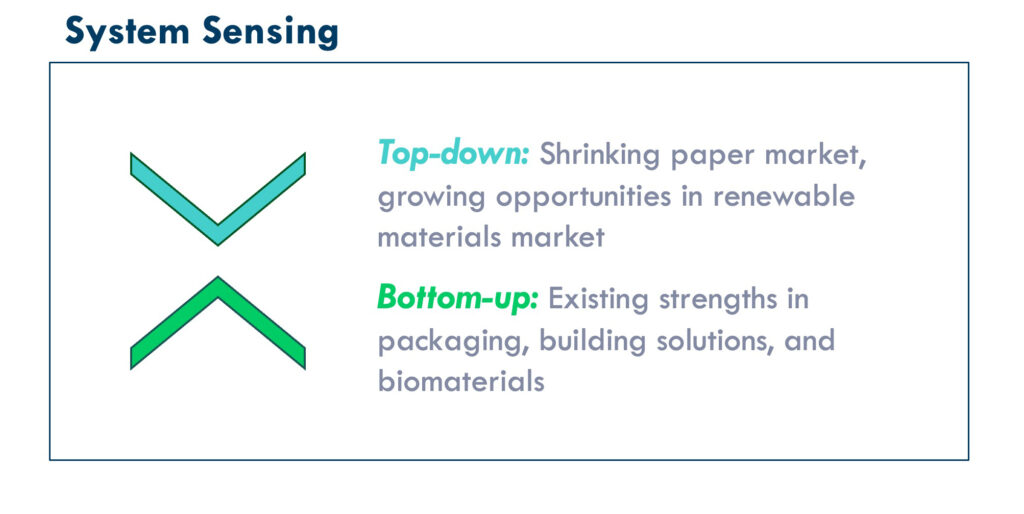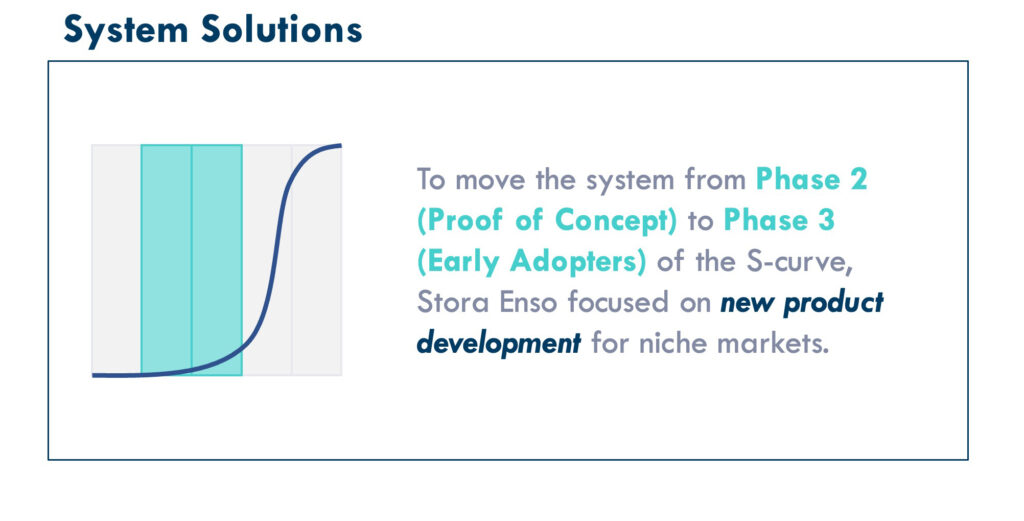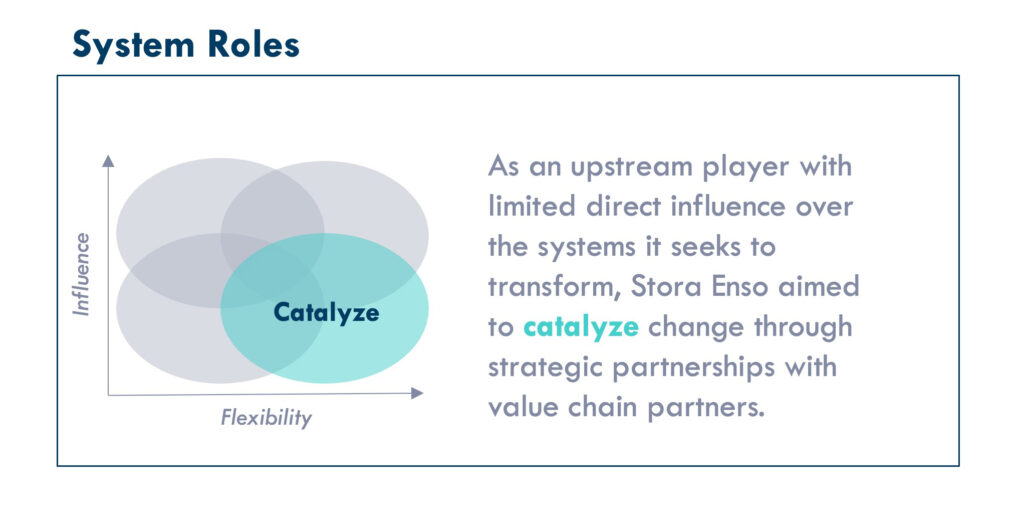
Emergence Strategy in Action: Stora Enso’s Transformation into a Renewable Materials Company
How a top paper manufacturer took advantage of global trends to push the frontier in the renewable materials field.
This is the second in a series exploring emergence strategy. For related case studies, click here.
In the mid-2000s, as electronic media took off, demand for paper started to fall. In fact, in the past twenty years, newsprint fell from 12 percent to less than 4 percent of global paper and paperboard production. That’s when one of the world’s top five paper manufacturers, Stora Enso, decided to make some big changes and become a renewable materials company.
Finnish company Stora Enso is one of the oldest companies in the world, with operations dating back to 1288. It recently gained recognition for pushing the frontier in the renewable materials field. Through the development of products such as plastic drinkware alternatives and sustainable building materials, in collaboration with partners downstream in the value chain, the company has sought to catalyze change in multiple systems and markets, especially food and buildings.
Staying Ahead of Global Trends
Stora Enso’s move to transform itself into a renewable materials company was rooted in the emerging market trends that could not be ignored. In the late 2000s, in a bid to restore profitability, Stora Enso brought on a new CEO and laid off over a third of its employees.
Against this backdrop, Stora Enso “made a strategic decision to generate as much cash as possible from the paper business and use it to invest in the growth opportunities related to global trends.” Specifically, the global trend that Stora Enso chose to pursue was the increasing demand for renewable materials. They focused on packaging, building solutions, and biomaterials innovations as areas where they saw themselves as having leading positions and able to build on existing strengths to grow more rapidly.
This transformation is an excellent example of an emergence strategy — a way of integrating systems thinking into corporate climate strategy development — that a company in a declining industry would take: pivoting to new, high-growth opportunities in the sustainability market. In addition, they have demonstrated a strong collaborative approach — a key facet of emergence strategy — by developing strategic partnerships to help find success in these new endeavors.
Single-company action is no longer enough — we need transformation of the entire production and consumption system, and that happens at the value chain level.
Driving Innovation
Stora Enso, recognizing a broader need for innovation in the materials industry, has launched several programs and partnerships aimed at fostering innovation and new product development. Guiding these efforts is a long-term target to bring in 15 percent of their annual revenue from new products and services that didn’t previously exist in their portfolio.
In 2017, Stora Enso launched the Stora Enso Accelerator Program in partnership with Aalto ENT and Vertical Accelerator. This program created opportunities for start-ups to work directly with Stora Enso employees on specific themes. In 2018, Stora Enso and KONE launched the Combient Foundry, a venture client program connecting startups with larger Nordic companies to form business partnerships. These initiatives have resulted in several partnerships, for example, with Sulapac to develop plastic drinkware alternatives, and with TRÄ to develop sustainable building solutions.
Influencing the Food System
Stora Enso has held a particular interest in the food industry given the important role of packaging in food preservation and transportation. In 2019, Stora Enso launched the 4evergreen Alliance in collaboration with value chain partners to increase the use of circular fiber-based packaging, through awareness raising, product design, recycling and collection system development, and more.
Since 2021, Stora Enso has been working with Tetra Pak to develop state-of-the-art carton recycling solutions in Europe. The existing Tetrapak design utilizes a multi-layer design of paper, plastic, and aluminum that makes it difficult to recycle — reportedly, only a quarter of the nearly 200 billion TetraPak packages sold every year are recycled. The Stora Enso and Tetra Pak partnership seeks to address this challenge by dramatically expanding carton recycling capacity at Stora Enso’s production sites: the first recycling line that began at Stora Enso’s Polish production site in June 2023 is set to triple the country’s annual carton recycling capacity, and is potentially able to absorb the recycling needs of all cartons sold in Poland. Similar arrangements are planned to follow in other countries. Long-term, TetraPak seeks to develop fully renewable, fully recyclable, and carbon-neutral packaging.
As product innovation advanced, Stora Enso also began looking more systematically at how they could influence sustainable transformation in the food system. In 2022, Stora Enso released a white paper on the role of packaging in the broader food system. The company identified four focus areas and 13 impact opportunities for packaging to contribute to better food systems, such as the reduction of food waste through optimized and smart packaging design, as well as the protection and restoration of land through sustainable sourcing, reduced input, and increased circularity. With this white paper, Stora Enso aims to spark collaboration among key stakeholders to act upon their recommendations and transform the food system.
Next Steps and Challenges
Despite their successes to date, Stora Enso still faces a number of challenges as they pursue their goal of system transformation in the food and packaging industries. Notably, Stora Enso has recently been in the headlines for weak financial performance — they have laid off about 1,150 employees and have brought on a new CEO. According to the company, these steps are meant to “allow the company to grow and be better equipped to support growing demand for its renewable products.”
Stora Enso must also be successful in scaling its product offerings — taking them from niche to mainstream — to transform downstream markets. Many of the opportunities that Stora Enso outlines in their white paper are also reliant on the cooperation and responsiveness of other system actors, including consumers, which may present additional challenges.
While these challenges are not insurmountable, how Stora Enso navigates these challenges will be a valuable lesson for other companies that may be considering similar pivots into the sustainability market.
The Emergence Strategy Framework
Stora Enso’s journey reflects a strong awareness of the key aspects of emergence strategy.
- System sensing
Stora Enso demonstrates how top-down and bottom-up systems sensing can be woven together to identify key opportunities for both business growth and system transformation. Their top-down sensing is reflected in their early recognition of key market trends, most notably the impact of the shrinking paper market on their business, as well as their identification of the renewable materials market not just as a growing market but also an impact opportunity space. Stora Enso’s bottom-up sensing is reflected in their decision to pursue product development that specifically built on their existing strengths in packaging, building solutions, and biomaterials.

- System solutions
Stora Enso’s focus on new product development is aligned with our five phases approach, which describes how different actions can be less or more impactful based on how mature a market is. The renewable materials market is still relatively nascent, with most activity focused on innovation or niche markets. Stora Enso’s efforts to accelerate innovation and to establish niche markets in partnerships with value chain partners thus demonstrate an accurate assessment of, and appropriate response to, market needs.

- System roles
Although Stora Enso is a major paper company, it is an upstream player in the systems it seeks to transform, such as food and buildings. To compensate for its limited direct influence in these target systems as an upstream player, Stora Enso has leveraged strategic partnerships with value chain partners, such as TetraPak and Danone in the food system, and the H&M group and Inter IKEA group in the textiles industry.

The story of Stora Enso’s transformation is still in progress, but already serves as a promising example of how large, established companies — and not just start-ups — can drive systems change toward a sustainable future, equipped with a bold vision and an open approach to collaboration.